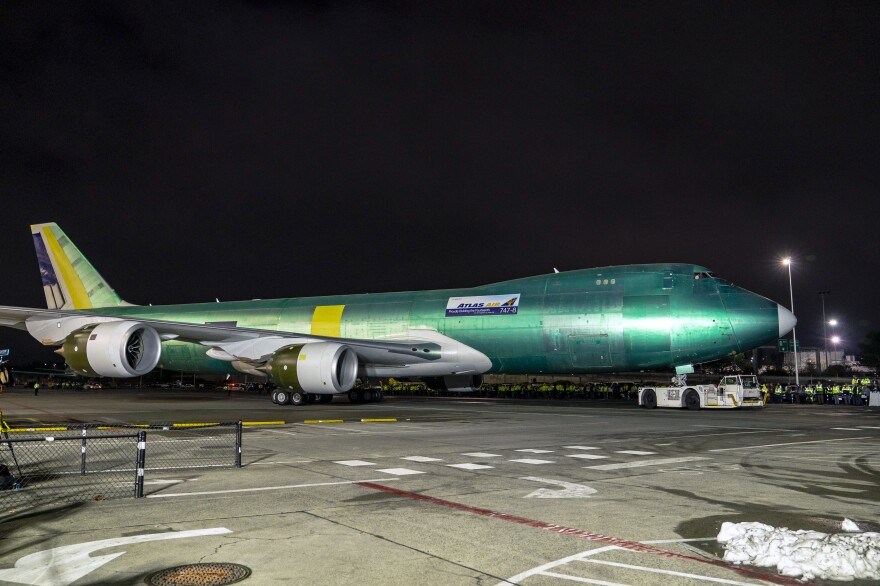The jet transformed an industry, bringing luxurious amenities and lengthy nonstop flights to the masses — all in a design that was both enormous and elegant. But the reign of the mighty 747 has ended, and Boeing says the last plane left its assembly line this week, after 54 years of production.
"For more than half a century, tens of thousands of dedicated Boeing employees have designed and built this magnificent airplane that has truly changed the world," Kim Smith, Boeing's vice president and general manager of the 747 and 767 programs, said as the company announced the end of production.
Since production of the 747 began in 1967, Boeing says, 1,574 of the airplanes were built. It started carrying commercial passengers in January 1970, when Pan Am used a 747 for a flight from New York to London.
The huge jet that shrank the world
The 747 was a hit at the Paris Air Show in 1969, and more than two dozen airlines raced to put the airliner into service, luring travelers with the 747's promise of comfort and unprecedented range.
People in the U.S. suddenly had an appealing option to visit Hawaii — which was then a very young state. And cities around the world became more interconnected by direct flights.
By the end of 1971, international airlines including Air Canada, Air India and Japan Airlines were using the aircraft.
The huge plane was touted as a win for middle-class travelers, under the idea that airline prices would become more affordable if carriers could fit more people onto a single flight. But that dynamic changed in later years, as the aviation industry saw a growing preference for smaller, more fuel-efficient planes and less focus on crowded, hub-to-hub flights.
The 747's star has been dimming — U.S. carriers phased it out in 2017 — but it had another moment in 2020, when a British Airways 747, aided by strong winds, traveled from New York to London in 4 hours, 56 minutes, setting a new record for the fastest subsonic commercial flight across the Atlantic.
The plane included movie screens and a lounge
The 747's expansive interior has repeatedly been compared to a living room, complete with large easy chairs and space to stretch one's legs.
A spiral staircase led to the upstairs lounge, with space for a bar. The lounge was originally intended to be a place where flight crews could take a break. But Pan Am's Juan Trippe — who made a $500 million deal with Boeing that set the 747 in motion — recommended a first-class passenger area instead, according to Northwestern University's Transportation Library.

Airlines put their own spin on the lounge, with names such as the Penthouse Lounge (TWA) and the Tea House in the Sky (Japan Airlines), according to the library.
Pan Am's advertising from that early era shows the plane's economy section comprised three spaces appointed like living rooms, each with its own movie system. Being on the 747, the airline said, was like being on a cruise ship.

It was designed to carry either passengers or cargo
The final 747 that rolled out of Boeing's assembly plant in Everett, Wash., is a cargo freighter, the 747-8 variant, destined for Atlas Air. That might seem like an odd end for a fabled airliner. But in many ways, the 747 sprang from plans for a massive military transport jet — a contract Boeing didn't win. Still, the company kept cargo in mind as it designed the new jet, including the ability to receive freight by hinging its cone-shaped nose.
Importantly, the Boeing used the advanced high-bypass engine technology considered for the military plane to lift the immense new airliner into the skies with hundreds of people aboard.
"One of the decisions we made was to be a good freighter as well as a good passenger plane," the 747's lead designer, the late Joe Sutter, told Smithsonian magazine in 2007. "That was probably one of the most important decisions we made, because it influenced [the size of the] fuselage. It's how the wide-body concept came into being."
The plane is entrenched in U.S. lore, providing the basis for Air Force One, the official presidential aircraft. Another modified version carried the space shuttle.
As lasting as the 747's legacy is, Boeing says it was first produced in only around 16 months, reflecting the combined work of thousands of employees.
The 747 was the first "jumbo jet"
And we mean jumbo: the 747's tail towers as tall as a six-story building. When it was introduced, the plane's 225-foot length dwarfed existing airliners.
"Pressurized, it carried a ton of air," Boeing says.
The jet had four engines and was the first to have two aisles running down a spacious passenger cabin.

It was so enormous that to construct it, Boeing had to build a new 200 million-cubic-foot assembly plant in Everett.
And Sutter was intent on the aircraft being extraordinarily safe, giving the 747 four sets of vital equipment like hydraulic systems and landing gear.
"You know things are going to happen, and sometimes it's going to be severe," Sutter told Smithsonian. "You still should be able to come home."
No more 747s are being made, but Boeing notes that they're still taking flight. The 1970s version even inspired one man to build a ground-based replica.
"We are proud that this plane will continue to fly across the globe for years to come," Boeing's Smith said.
Copyright 2022 NPR. To see more, visit https://www.npr.org. 9(MDAyNDY5MjM1MDEyODE2MzMyMTZmZDQwMg001))




